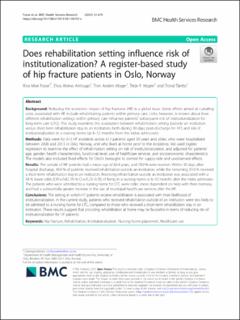| dc.contributor.author | Fosse, Rina Moe | |
| dc.contributor.author | Ambugo, Eliva Atieno | |
| dc.contributor.author | Moger, Tron Anders | |
| dc.contributor.author | Hagen, Terje P. | |
| dc.contributor.author | Tjerbo, Trond | |
| dc.date.accessioned | 2022-03-17T13:38:00Z | |
| dc.date.available | 2022-03-17T13:38:00Z | |
| dc.date.created | 2021-08-18T09:12:27Z | |
| dc.date.issued | 2021 | |
| dc.identifier.citation | Fosse, R. M., Ambugo, E. A., Moger, T. A., Hagen, T. P. & Tjerbo, T. (2021). Does rehabilitation setting influence risk of institutionalization? A register-based study of hip fracture patients in Oslo, Norway. BMC Health Services Research, 21(1), Artikkel 678. | en_US |
| dc.identifier.issn | 1472-6963 | |
| dc.identifier.uri | https://hdl.handle.net/11250/2985895 | |
| dc.description.abstract | Background: Reducing the economic impact of hip fractures (HF) is a global issue. Some efforts aimed at curtailing costs associated with HF include rehabilitating patients within primary care. Little, however, is known about how different rehabilitation settings within primary care influence patients’ subsequent risk of institutionalization for long-term care (LTC). This study examines the association between rehabilitation setting (outside an institution versus short-term rehabilitation stay in an institution, both during 30 days post-discharge for HF) and risk of institutionalization in a nursing home (at 6–12 months from the index admission).
Methods: Data were for 612 HF incidents across 611 patients aged 50 years and older, who were hospitalized between 2008 and 2013 in Oslo, Norway, and who lived at home prior to the incidence. We used logistic regression to examine the effect of rehabilitation setting on risk of institutionalization, and adjusted for patients’ age, gender, health characteristics, functional level, use of healthcare services, and socioeconomic characteristics. The models also included fixed-effects for Oslo’s boroughs to control for supply-side and unobserved effects.
Results: The sample of HF patients had a mean age of 82.4 years, and 78.9 % were women. Within 30 days after hospital discharge, 49.0 % of patients received rehabilitation outside an institution, while the remaining 51.0 % received a short-term rehabilitation stay in an institution. Receiving rehabilitation outside an institution was associated with a 58 % lower odds (OR = 0.42, 95 % CI = 0.23–0.76) of living in a nursing home at 6–12 months after the index admission. The patients who were admitted to a nursing home for LTC were older, more dependent on help with their memory, and had a substantially greater increase in the use of municipal healthcare services after the HF.
Conclusions: The setting in which HF patients receive rehabilitation is associated with their likelihood of institutionalization. In the current study, patients who received rehabilitation outside of an institution were less likely to be admitted to a nursing home for LTC, compared to those who received a short-term rehabilitation stay in an institution. These results suggest that providing rehabilitation at home may be favorable in terms of reducing risk of institutionalization for HF patients. | en_US |
| dc.language.iso | eng | en_US |
| dc.rights | Navngivelse 4.0 Internasjonal | * |
| dc.rights.uri | http://creativecommons.org/licenses/by/4.0/deed.no | * |
| dc.title | Does rehabilitation setting influence risk of institutionalization? A register-based study of hip fracture patients in Oslo, Norway | en_US |
| dc.type | Peer reviewed | en_US |
| dc.type | Journal article | en_US |
| dc.description.version | publishedVersion | en_US |
| dc.rights.holder | © The Author(s). 2021. | en_US |
| dc.source.volume | 21 | en_US |
| dc.source.journal | BMC Health Services Research | en_US |
| dc.source.issue | 1 | en_US |
| dc.identifier.doi | https://doi.org/10.1186/s12913-021-06703-x | |
| dc.identifier.cristin | 1926835 | |
| dc.relation.project | Norges forskningsråd: 296114 | en_US |
| dc.source.articlenumber | 678 | en_US |
| cristin.ispublished | true | |
| cristin.fulltext | original | |
| cristin.qualitycode | 2 | |

